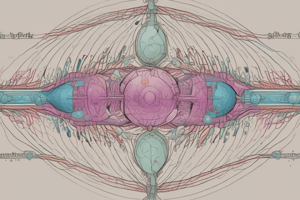Podcast
Questions and Answers
What is the primary hormone responsible for the development and expression of sexual behavior in male animals?
What is the primary hormone responsible for the development and expression of sexual behavior in male animals?
- Testosterone (correct)
- Progesterone
- Estrogen
- Insulin
Which hormone stimulates the growth and maturation of the uterine lining in preparation for pregnancy?
Which hormone stimulates the growth and maturation of the uterine lining in preparation for pregnancy?
- Estrogen (correct)
- Progesterone
- Adrenaline
- Testosterone
What is the period of time during which an animal is not receptive to mating?
What is the period of time during which an animal is not receptive to mating?
- Postcopulatory Behavior
- Breeding Programs
- Refractory Period (correct)
- Sexual Motivation
Which hormone increases sexual desire and aggression in animals?
Which hormone increases sexual desire and aggression in animals?
What is the term for the display of sexual behavior in animals?
What is the term for the display of sexual behavior in animals?
Which hormone plays a crucial role in the regulation of the menstrual cycle?
Which hormone plays a crucial role in the regulation of the menstrual cycle?
What is the term for the behavior displayed by males during courtship?
What is the term for the behavior displayed by males during courtship?
What is the term for controlled breeding programs for animals?
What is the term for controlled breeding programs for animals?
What is the primary focus of reproductive behavior in animals?
What is the primary focus of reproductive behavior in animals?
During which stage of reproductive behavior do animals exhibit physical and social interactions?
During which stage of reproductive behavior do animals exhibit physical and social interactions?
What is the term for the period of time after mating when an animal is not receptive to further mating?
What is the term for the period of time after mating when an animal is not receptive to further mating?
What is the primary function of oxytocin from the posterior pituitary during the emission phase of ejaculation?
What is the primary function of oxytocin from the posterior pituitary during the emission phase of ejaculation?
What drives an animal's desire to engage in reproductive behavior?
What drives an animal's desire to engage in reproductive behavior?
What is the term for the physiological changes that occur in an animal in preparation for mating?
What is the term for the physiological changes that occur in an animal in preparation for mating?
Which of the following best describes the refractory period in male animals?
Which of the following best describes the refractory period in male animals?
What is the primary goal of breeding programs in animals?
What is the primary goal of breeding programs in animals?
What is the primary motivator for sexual behavior in male animals?
What is the primary motivator for sexual behavior in male animals?
During which week of the course schedule is the topic of reproductive failure covered?
During which week of the course schedule is the topic of reproductive failure covered?
Which of the following is an example of postcopulatory behavior in male animals?
Which of the following is an example of postcopulatory behavior in male animals?
What percentage of the final grade is the final exam worth?
What percentage of the final grade is the final exam worth?
What is the role of vasodilatation during erection?
What is the role of vasodilatation during erection?
Which of the following breeding programs would benefit from an understanding of male copulatory behavior?
Which of the following breeding programs would benefit from an understanding of male copulatory behavior?
What is the primary endocrine effect of oxytocin during ejaculation?
What is the primary endocrine effect of oxytocin during ejaculation?
Which of the following is a characteristic of sustained copulators?
Which of the following is a characteristic of sustained copulators?
Flashcards are hidden until you start studying
Study Notes
Endocrine Effects on Sexual Behavior
- Hormones play a crucial role in regulating sexual behavior in animals by controlling physiological and psychological aspects of mating and reproduction.
- Testosterone, produced by the testes, promotes the development of secondary sexual characteristics in males, such as increased muscle mass, body hair, and deepening of the voice.
- Testosterone also stimulates the production of sperm and increases sexual desire and aggression in males.
- Estrogen, produced by the ovaries, promotes the development of secondary sexual characteristics in females, such as breast development and widening of the hips.
- Estrogen also stimulates the growth and maturation of the uterine lining in preparation for pregnancy.
Copulatory Behavior
- Male copulatory behavior involves erection, mounting, intromission, and ejaculation.
- There are three types of copulators: short copulators (1-3 seconds), sustained copulators (5-20 minutes), and intermediate copulators (20-60 seconds).
- Examples of short copulators include bulls, rams, and boars, while stallions are sustained copulators.
Erection, Emission, and Ejaculation
- Erection involves vasodilatation, relaxation of the retractor penis muscle, and contraction of the cauda epididymis and vas deferens.
- Emission involves the release of accessory gland fluid and is triggered by oxytocin from the posterior pituitary and sympathetic neurons.
- Ejaculation involves the contraction of smooth and striated muscles.
Female Copulatory Behavior
- Female copulatory behavior involves receptivity and estrus detection, leading to mating with a male.
- Estrus pattern and estrus detection are important aspects of female copulatory behavior.
Postcopulatory Behavior
- Postcopulatory behavior in males refers to the behaviors exhibited after mating has occurred.
Reproductive Behavior
- Reproductive behavior involves a series of stages, including attraction, courtship, mating, and post-copulatory behaviors.
- Reproductive behavior varies widely between different species of animals and even between different individuals within the same species.
Studying That Suits You
Use AI to generate personalized quizzes and flashcards to suit your learning preferences.




